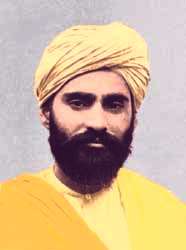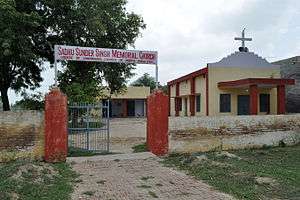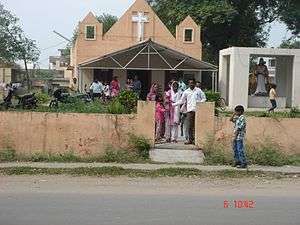Sadhu Sundar Singh
| Sadhu Sundar Singh | |
|---|---|
 | |
| Born |
3 September 1889 Ludhiana, Punjab, British India (present-day Punjab, India) |
| Died |
unknown Himalayas |
| Education | Anglican College, Lahore Eving Christian School, Ludhiana, Punjab, India |
Congregations served | Reformers |
| Title | Sadhu |
Sadhu Sundar Singh (Punjabi: ਸਾਧੂ ਸੁੰਦਰ ਸਿੰਘ (Gurmukhi); سادھو سندر سنگھ (Shahmukhi); born 3 September 1889) was an Indian Christian missionary. He is believed to have died in the foothills of the Himalayas in 1929.
Biography
Early years
Sundar Singh[1] was born into a Sikh family in the village of Rampur Kataania, Ludhiana (Punjab state) in northern India. Sundar Singh's mother took him to sit at the feet of a sadhu, an ascetic holy man, who lived in the jungle some miles away, while also sending him to Ewing Christian High School, Ludhiana, to learn English. Sundar Singh's mother died when he was fourteen. In anger, he burned a Bible page by page while his friends watched.[2]


Conversion to Christianity
Sundar felt that his religious pursuits in Sikhism and the questioning of Christian and Hindu priests left him without ultimate meaning. Sundar resolved to kill himself by throwing himself upon a railroad track. He asked that whosoever is the 'True God' would appear before him, or else he would kill himself; that very night he had an vision of Jesus. Sundar announced to his father, Sher Singh, that henceforth he would get converted into the missionary work of Christ. His father officially rejected him, and his brother Rajender Singh attempted to poison him. He was not poisoned just once but a number of times. People of that area threw snakes in his house, but he was rescued from mistreatment by the help of a nearby British funded Christian community.[3]
On his sixteenth birthday, he was publicly baptised as a Christian in the parish church in Simla,[2] in the Himalayan foothills. Prior to this he had been staying at the Christian Missionary Home at Sabathu, near Simla, serving the leprosy patients there.
Life of servitude
.jpg)
In October 1906, he set out on his journey as a new Christian, wearing a saffron turban and the saffron robe of a Hindu sadhu, an ascetic devoted to spiritual practice. Singh propagated himself as a sadhu, albeit one within Christianity rather than Hinduism, because he realized Hindus could not be converted in India unless it was in an Indian way.[2]
"I am not worthy to follow in the steps of my Lord," he said, "but, like Him, I want no home, no possessions. Like Him I will belong to the road, sharing the suffering of my people, eating with those who will give me shelter, and telling all men of the love of God."
After returning to his home village, where he was given an unexpectedly warm welcome, Sundar Singh traveled northward for his mission of converting through the Punjab, over the Bannihal Pass into Kashmir, and then back through Muslim Afghanistan and into the brigand-infested North-West Frontier and Baluchistan. He was referred to as "the apostle with the bleeding feet" by the Christian communities of the north. He suffered arrest and stoning for his beliefs, and experienced mystical encounters.
In 1908, he crossed the frontier of Tibet, where he was appalled by the living conditions. He was stoned as he bathed in cold water because it was believed that "holy men never washed."
In 1908 he went to Bombay, hoping to board a ship to visit Palestine but was refused a permit, and had to return to the north.
He realized during his stay in missions that Western civilization had become the antithesis of original Christian values. He was disillusioned with the materialism and colonialism of western society and tried to forge an Indian identity for Indian church. He used to lament that Indian Christians adopt British customs, literature and dresses which have nothing to do with Christianity and Christ.
Formal Christian training
In December 1909 Singh began training for the Christian ministry at the Anglican college in Lahore. According to his biographers, he did not form close relationships with fellow students, meeting them only at meal times and designated prayer sessions. He was ostracised for being "different".
Although Singh had been baptised by an Anglican priest, he was ignorant of the ecclesiastical culture and conventions of Anglicanism. His inability to adapt hindered him from fitting in with the routines of academic study. Much in the college course seemed irrelevant to the gospel as India needed to hear it. After eight months in the college, Singh left in July 1910.
It has been claimed by his biographers that Singh's withdrawal was due to stipulations laid down by Bishop Lefroy. As an ordained Anglican priest, Singh was told to discard his sadhu's robe and wear "respectable" European clerical dress, use formal Anglican worship, sing English hymns; and not preach outside his parish without permission. As an ardent devotee of Christ who was only interested in spreading his message, he rejected the mixing of Jesus Christ and essentially British culture.
Helping others
Stories from those years are astonishing and sometimes incredible and full of miracles which helped in conversion. Indeed, there were those, who insisted that they were mystical rather than real happenings. That first year, 1912, he returned with an extraordinary account of finding a three-hundred-year-old hermit in a mountain cave—the Maharishi of Kailas, with whom he spent some weeks in deep fellowship.
According to Singh, in a town called Rasar he had been thrown into a dry well full of bones and rotting flesh and left to die, but three days later he was rescued.[4]
At these and at other times Singh was said to have been rescued by members of the "Sannyasi Mission"—secret disciples of Jesus wearing Hindu markings, whom he allegedly claimed to have found all over India.
The secret Sannyasi Mission is alleged to have numbered around 24,000 members across India.[5] The origins of this brotherhood were reputed to be linked to one of the Magi at Christ's nativity and then the second century AD disciples of the apostle Thomas circulating in India. Nothing was heard of this evangelistic fellowship until William Carey began his missionary work in Serampore. The Maharishi of Kailas experienced ecstatic visions about the secret fellowship that he retold to Sundar Singh, and Singh himself built his spiritual life around visions.[6]
Whether he won many continuing disciples on these hazardous Tibetan treks is not known. One reason why no one believed his version of story was because Singh did not keep written records and he was unaccompanied by any other Christian disciples who might have witnessed the events.
Travels abroad
During his twenties, Sundar Singh's Gospel work widened greatly, and long before he was thirty, his name and picture were familiar all over the Christian world. He described a struggle with Satan to retain his humility, but people described him as always human, approachable and humble, with a sense of fun and a love of nature. This character, with his illustrations from ordinary life, gave his addresses great impact. Many people said, "He not only looks like Jesus, he talks like Jesus must have talked." His talks and his personal speech were informed by his habitual early morning meditation, especially on the gospels. In 1918 he made a long tour of South India and Ceylon, and the following year he was invited to Burma, Malaya, China and Japan.
Some of the stories from these tours were as strange as any of his Tibetan adventures. He claimed power over wild things. He claimed even to have power over disease and illness, though he never allowed his presumed healing gifts to be publicised.
For a long time Sundar Singh had wanted to visit Britain, and the opportunity came when his father, Sher Singh, who was converted too gave him the money for his fare to Britain. He visited the West twice, travelling to Britain, the United States and Australia in 1920, and to Europe again in 1922. He was welcomed by Christians of many traditions, and his words searched the hearts of people who now faced the aftermath of World War I and who seemed to evidence a shallow attitude to life. Singh was appalled by what he saw as the materialism, emptiness and irreligion he found everywhere, contrasting it with Asia's awareness of God, no matter how limited that might be. Once back in India he continued his Gospel-proclamation work, though it was clear that he was getting more physically frail.
Final trip
In 1923 Sundar Singh made the last of his regular summer visits to Tibet and came back exhausted. His preaching days were apparently over, and in the next years, in his own home or those of his friends in the Simla hills he gave himself to meditation, fellowship, and writing some of the things he had lived to preach.
In 1929, against all his friends' advice, Singh determined to make one last journey to Tibet. He was last seen on 18 April 1929 setting off on this journey. In April he reached Kalka, a small town below Simla, a prematurely aged figure in his yellow robe among pilgrims and holy men who were beginning their own trek to one of Hinduism's holy places some miles away. Where he went after that is unknown. Whether he died of exhaustion or reached the mountains remains a mystery.
In the early 1940s Bishop Dr. Augustine Peters, another converted missionary of South India, sought out Sundar's brother Rajender Singh, led him to the Christian faith and baptised him in Punjab. Rajender referred to many alleged miracles performed by Sundar Singh and people converted to Christ under his ministry. [7]
Sadhu Sundar Singh is treasured by many as a formative towering figure in the missionary history of the Christian church in India.
Timeline
- 1889 – Born at Rampur Kataania, Ludhiana, Punjab
- 1903 – Conversion
- 1904 – Cast out from home
- 1905 – Baptised in Simla; begins life as a sadhu
- 1907 – Works in leprosy hospital at Sabathu
- 1908 – First visit to Tibet
- 1909 – Enters Divinity College, Lahore, to train for the ministry
- 1911 – Hands back his preacher's license; returns to the sadhu's life
- 1912 – Tours through north India and the Buddhist states of the Himalayas
- 1918 to 1922 – Travels worldwide
- 1923 – Turned back from Tibet
- 1925 to 1927 – Quietly spends time writing
- 1927 – Sets out for Tibet but returns due to illness
- 1929 – Final attempt to reach Tibet
- 1972 – Sadhu Sundar Singh Evangelical Association formed
Works by Sundar Singh
Sundar Singh wrote eight books between 1922 and 1929. His manuscripts were written in Urdu, and later translated into English and other languages.
- At the Master's Feet (London: Fleming H. Revell, 1922). Electronic versions: Google Books and CCEL.
- With and Without Christ (London: Cassell; New York: Harper & Brothers, 1929).
- The Real Life (published posthumously; Madras: CLS, 1965).
- The Real Pearl (published posthumously; Madras: CLS, 1966).
- Reality and Religion: Meditations on God, Man and Nature (London: Macmillan, 1924).
- The Search after Reality: Thoughts on Hinduism, Buddhism, Muhammadanism and Christianity (London: Macmillan, 1925).
- Meditations on Various Aspects of the Spiritual Life (London: Macmillan, 1926).
- Visions of the Spiritual World (London: Macmillan, 1926).
A number of his works were compiled and edited by others:
- The Cross Is Heaven: The Life and Writings of Sadhu Sundar Singh, edited by A. J. Appasamy (London: Lutterworth Press, 1956). – A collection of short articles by Sundar Singh.
- Life in Abundance, edited by A. F. Thyagaraju (Madras: CLS, 1980). – This is a collection of transcripts of his sermons, preached in Switzerland in March 1922, as recorded by Alys Goodwin.
- The Christian Witness of Sadhu Sundar Singh: A Collection of His Writings, edited by T. Dayanandan Francis (Madras, India: The Christian Literature Society, 1989).
References
- ↑ "Sadhu Sundar Singh Movie in Urdu Hindi". Youtube.
- 1 2 3 "Sadhu Sundar Singh", CCEL
- ↑ Parker, Mrs. Arthur. Sadhu Sundar Singh: Called of God, (London: Fleming H. Revell Company, 1920) p. 28-29.
- ↑ Parker, p. 64-65.
- ↑ Eric J. Sharpe, The Riddle of Sadhu Sundar Singh (New Delhi: Intercultural Publications, 2004 ISBN 81-85574-60-X), p.64.
- ↑ Sharpe, Riddle of Sadhu Sundar Singh, p. 65.
- ↑ "Life Message of Bishop Augustine Peters 1930 to 2010". Anpministry.org. Retrieved 2014-05-15.
Further reading
- Paul Gaebler: Sadhu Sundar Singh, Leipzig 1937 (German).
- Perumalla Surya Prakash, The Preaching of Sadhu Sundar Singh: A Homiletic Analysis of Independent Preaching and Personal Christianity", Bangalore: Wordmakers, 1991. (Perumalla Surya Prakash, The Preaching of Sadhu Sundar Singh: A Homiletic Analysis of Independent Preaching and Personal Christianity, Wordmakers, Bengaluru (Bangalore), 1991. Google Books. Internet, accessed 30 November 2008. )
- Perumalla Surya Prakash, Sadhu Sundar Singh's Contribution,(Perumalla Surya Prakash, Sadhu Sundar Singh's Contribution in Roger E. Hedlund (Edited), Christianity is Indian: The Emergence of an Indigenous Community, Revised edition, ISPCK, New Delhi, 2004, pp.113-128.) in Roger E. Hedlund (Edited), Christianity is Indian: The Emergence of an Indigenous Community, Revised edition, ISPCK, New Delhi, 2004, pp.113-128
- Appasamy, A. J. Sundar Singh. Cambridge: Lutterworth, 1958.
- Benge, Janet & Geoff Sundar Singh: Footprints Over the Mountains
- Davey, Cyril J. The Story of Sadhu Sundar Singh (Chicago: Moody Press, 1963); reprinted as Sadhu Sundar Singh (Bromley: STL Books, 1980).
- Francis, Dayanandan, ed. The Christian Witness of Sadhu Sundar Singh. Alresford: Christian Literature Society, 1989.
- Stevens, Alec, Sadhu Sundar Singh (Dover, NJ: Calvary Comics, 2006).
- Streeter, Burnett and A. J. Appasamy. The Sadhu: a Study in Mysticism and Practical Religion. London: Macmillan, 1921.
- Thompson, Phyllis, Sadhu Sundar Singh (Carlisle: Operation Mobilisation, 1992).
- Watson, Janet Lynn. The Saffron Robe. London: Hodder and Stoughton,1975.
- Woodbridge, John. More Than Conquerors. Australia, 1992.
- Benge, Geoff and Janet. "Sundar Singh: Footprints Over the Mountains" (Christian Heroes: Then and Now Series)
- Much of the above detail was provided by this book.
- Andrews, C. F. Sadhu Sundar Singh: A Personal Memoir. New York: Harper & Brothers, 1934.
- Joyce Reason. The man who disappeared: Sundar Singh of India. London: Edinburgh House Press, 1937